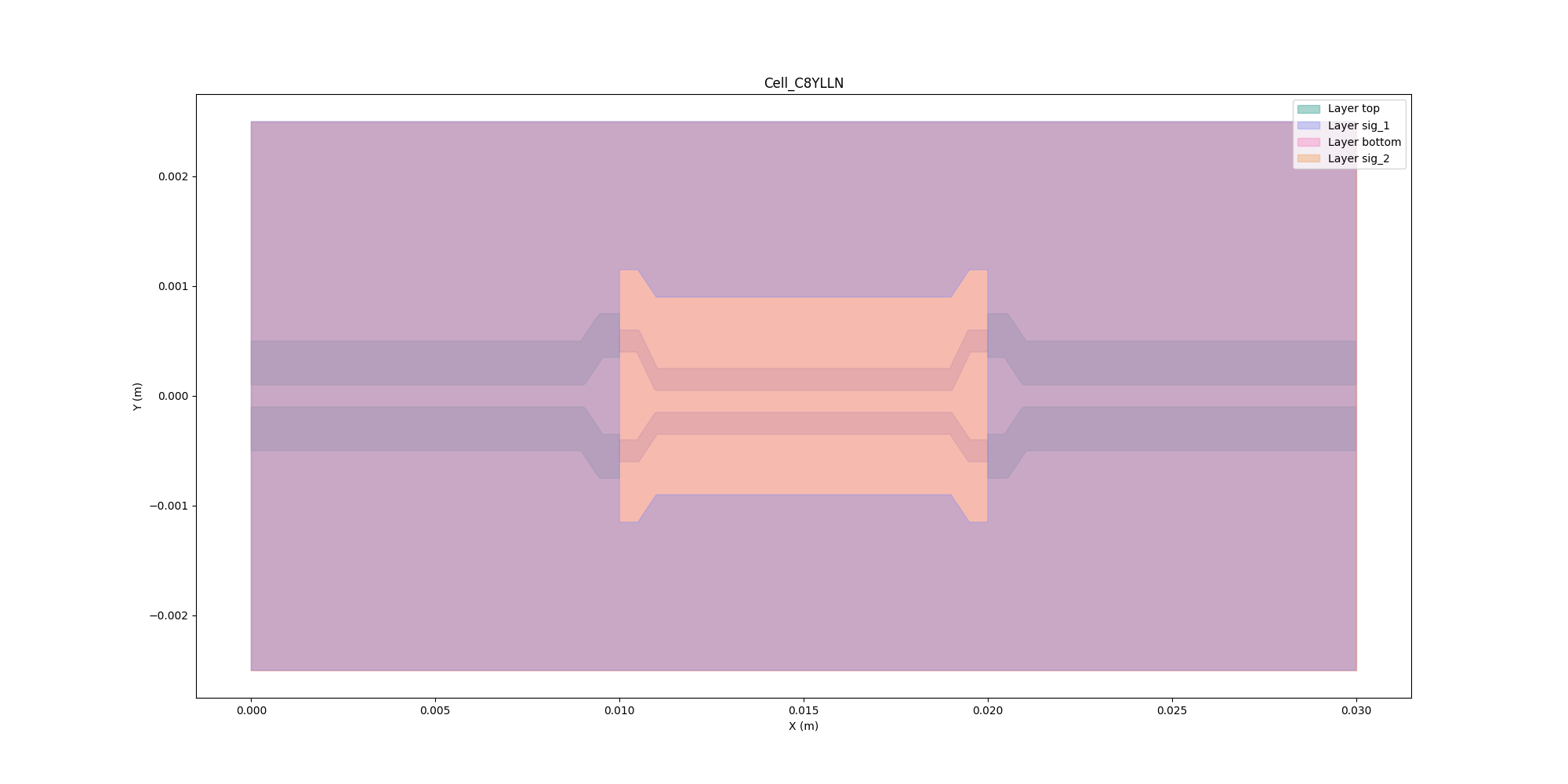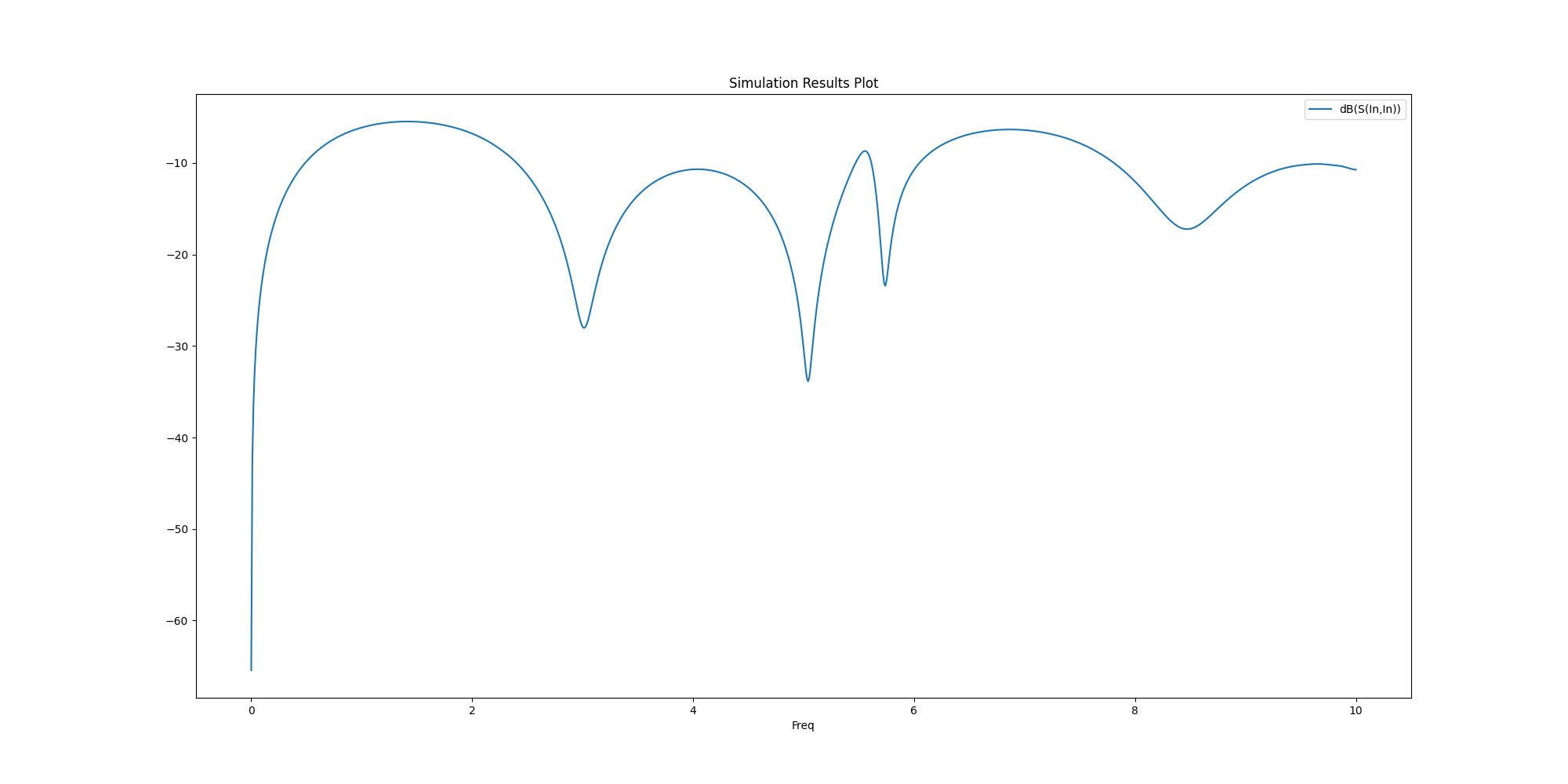Note
Go to the end to download the full example code
EDB: fully parametrized design#
This example shows how you can use HFSS 3D Layout to create and solve a parametric design.
Perform required imports#
Perform required imports, which includes importing the Hfss3dlayout object
and initializing it on version 2023 R2.
import pyaedt
import os
Set non-graphical mode#
Set non-graphical mode. The default is False.
non_graphical = False
Launch EDB#
Launch EDB.
aedb_path = os.path.join(pyaedt.generate_unique_folder_name(), pyaedt.generate_unique_name("pcb") + ".aedb")
print(aedb_path)
edb = pyaedt.Edb(edbpath=aedb_path, edbversion="2023.2")
D:\Temp\pyaedt_prj_BSL\pcb_5033PM.aedb
Define parameters#
Define the parameters.
params = {"$ms_width": "0.4mm",
"$sl_width": "0.2mm",
"$ms_spacing": "0.2mm",
"$sl_spacing": "0.1mm",
"$via_spacing": "0.5mm",
"$via_diam": "0.3mm",
"$pad_diam": "0.6mm",
"$anti_pad_diam": "0.7mm",
"$pcb_len": "30mm",
"$pcb_w": "5mm",
"$x_size": "1.2mm",
"$y_size": "1mm",
"$corner_rad": "0.5mm"}
for par_name in params:
edb.add_project_variable(par_name, params[par_name])
Define stackup layers#
Define the stackup layers from bottom to top.
layers = [{"name": "bottom", "layer_type": "signal", "thickness": "35um", "material": "copper"},
{"name": "diel_3", "layer_type": "dielectric", "thickness": "275um", "material": "FR4_epoxy"},
{"name": "sig_2", "layer_type": "signal", "thickness": "35um", "material": "copper"},
{"name": "diel_2", "layer_type": "dielectric", "thickness": "275um", "material": "FR4_epoxy"},
{"name": "sig_1", "layer_type": "signal", "thickness": "35um", "material": "copper"},
{"name": "diel_1", "layer_type": "dielectric", "thickness": "275um", "material": "FR4_epoxy"},
{"name": "top", "layer_type": "signal", "thickness": "35um", "material": "copper"}]
# Create EDB stackup.
# Bottom layer
prev = None
for layer in layers:
edb.stackup.add_layer(layer["name"], base_layer=prev, layer_type=layer["layer_type"], thickness=layer["thickness"],
material=layer["material"])
prev = layer["name"]
Create padstack for signal via#
Create a parametrized padstack for the signal via.
signal_via_padstack = "automated_via"
edb.padstacks.create(
padstackname=signal_via_padstack,
holediam="$via_diam",
paddiam="$pad_diam",
antipaddiam="",
antipad_shape="Bullet",
x_size="$x_size",
y_size="$y_size",
corner_radius="$corner_rad",
start_layer=layers[-1]["name"],
stop_layer=layers[-3]["name"]
)
'automated_via'
Assign net names#
# Assign net names. There are only two signal nets.
Place signal vias#
Place signal vias.
edb.padstacks.place(
position=["$pcb_len/3", "($ms_width+$ms_spacing+$via_spacing)/2"],
definition_name=signal_via_padstack,
net_name=net_p,
via_name="",
rotation=90.0
)
edb.padstacks.place(
position=["2*$pcb_len/3", "($ms_width+$ms_spacing+$via_spacing)/2"],
definition_name=signal_via_padstack,
net_name=net_p,
via_name="",
rotation=90.0,
)
edb.padstacks.place(
position=["$pcb_len/3", "-($ms_width+$ms_spacing+$via_spacing)/2"],
definition_name=signal_via_padstack,
net_name=net_n,
via_name="",
rotation=-90.0,
)
edb.padstacks.place(
position=["2*$pcb_len/3", "-($ms_width+$ms_spacing+$via_spacing)/2"],
definition_name=signal_via_padstack,
net_name=net_n,
via_name="",
rotation=-90.0,
)
# ###############################################################################
# Draw parametrized traces
# ~~~~~~~~~~~~~~~~~~~~~~~~
# Draw parametrized traces.
# Trace the width and the routing (Microstrip-Stripline-Microstrip).
# Applies to both p and n nets.
width = ["$ms_width", "$sl_width", "$ms_width"] # Trace width, n and p
route_layer = [layers[-1]["name"], layers[4]["name"], layers[-1]["name"]] # Routing layer, n and p
# Define points for three traces in the "p" net
points_p = [
[["0.0", "($ms_width+$ms_spacing)/2"],
["$pcb_len/3-2*$via_spacing", "($ms_width+$ms_spacing)/2"],
["$pcb_len/3-$via_spacing", "($ms_width+$ms_spacing+$via_spacing)/2"],
["$pcb_len/3", "($ms_width+$ms_spacing+$via_spacing)/2"],
],
[["$pcb_len/3", "($ms_width+$sl_spacing+$via_spacing)/2"],
["$pcb_len/3+$via_spacing", "($ms_width+$sl_spacing+$via_spacing)/2"],
["$pcb_len/3+2*$via_spacing", "($sl_width+$sl_spacing)/2"],
["2*$pcb_len/3-2*$via_spacing", "($sl_width+$sl_spacing)/2"],
["2*$pcb_len/3-$via_spacing", "($ms_width+$sl_spacing+$via_spacing)/2"],
["2*$pcb_len/3", "($ms_width+$sl_spacing+$via_spacing)/2"],
],
[["2*$pcb_len/3", "($ms_width+$ms_spacing+$via_spacing)/2"],
["2*$pcb_len/3+$via_spacing", "($ms_width+$ms_spacing+$via_spacing)/2"],
["2*$pcb_len/3+2*$via_spacing", "($ms_width+$ms_spacing)/2"],
["$pcb_len", "($ms_width+$ms_spacing)/2"],
],
]
# Define points for three traces in the "n" net
points_n = [
[["0.0", "-($ms_width+$ms_spacing)/2"],
["$pcb_len/3-2*$via_spacing", "-($ms_width+$ms_spacing)/2"],
["$pcb_len/3-$via_spacing", "-($ms_width+$ms_spacing+$via_spacing)/2"],
["$pcb_len/3", "-($ms_width+$ms_spacing+$via_spacing)/2"],
],
[["$pcb_len/3", "-($ms_width+$sl_spacing+$via_spacing)/2"],
["$pcb_len/3+$via_spacing", "-($ms_width+$sl_spacing+$via_spacing)/2"],
["$pcb_len/3+2*$via_spacing", "-($ms_width+$sl_spacing)/2"],
["2*$pcb_len/3-2*$via_spacing", "-($ms_width+$sl_spacing)/2"],
["2*$pcb_len/3-$via_spacing", "-($ms_width+$sl_spacing+$via_spacing)/2"],
["2*$pcb_len/3", "-($ms_width+$sl_spacing+$via_spacing)/2"],
],
[["2*$pcb_len/3", "-($ms_width+$ms_spacing+$via_spacing)/2"],
["2*$pcb_len/3 + $via_spacing", "-($ms_width+$ms_spacing+$via_spacing)/2"],
["2*$pcb_len/3 + 2*$via_spacing", "-($ms_width+$ms_spacing)/2"],
["$pcb_len", "-($ms_width + $ms_spacing)/2"],
],
]
# ###############################################################################
# Add traces to EDB
# ~~~~~~~~~~~~~~~~~
# Add traces to EDB.
trace_p = []
trace_n = []
for n in range(len(points_p)):
trace_p.append(edb.modeler.create_trace(points_p[n], route_layer[n], width[n], net_p, "Flat", "Flat"))
trace_n.append(edb.modeler.create_trace(points_n[n], route_layer[n], width[n], net_n, "Flat", "Flat"))
Create wave ports#
Create wave ports:
edb.hfss.create_differential_wave_port(trace_p[0].id, ["0.0", "($ms_width+$ms_spacing)/2"],
trace_n[0].id, ["0.0", "-($ms_width+$ms_spacing)/2"],
"wave_port_1")
edb.hfss.create_differential_wave_port(trace_p[2].id, ["$pcb_len", "($ms_width+$ms_spacing)/2"],
trace_n[2].id, ["$pcb_len", "-($ms_width + $ms_spacing)/2"],
"wave_port_2")
('wave_port_2', <pyaedt.edb_core.edb_data.ports.BundleWavePort object at 0x000001D9EE029F60>)
Draw ground polygons#
Draw ground polygons.
gnd_poly = [[0.0, "-$pcb_w/2"],
["$pcb_len", "-$pcb_w/2"],
["$pcb_len", "$pcb_w/2"],
[0.0, "$pcb_w/2"]]
gnd_shape = edb.modeler.Shape("polygon", points=gnd_poly)
# Void in ground for traces on the signal routing layer
void_poly = [["$pcb_len/3", "-($ms_width+$ms_spacing+$via_spacing+$anti_pad_diam)/2-$via_spacing/2"],
["$pcb_len/3 + $via_spacing", "-($ms_width+$ms_spacing+$via_spacing+$anti_pad_diam)/2-$via_spacing/2"],
["$pcb_len/3 + 2*$via_spacing",
"-($ms_width+$ms_spacing+$via_spacing+$anti_pad_diam)/2"],
["2*$pcb_len/3 - 2*$via_spacing",
"-($ms_width+$ms_spacing+$via_spacing+$anti_pad_diam)/2"],
["2*$pcb_len/3 - $via_spacing",
"-($ms_width+$ms_spacing+$via_spacing+$anti_pad_diam)/2-$via_spacing/2"],
["2*$pcb_len/3", "-($ms_width+$ms_spacing+$via_spacing+$anti_pad_diam)/2-$via_spacing/2"],
["2*$pcb_len/3", "($ms_width+$ms_spacing+$via_spacing+$anti_pad_diam)/2+$via_spacing/2"],
["2*$pcb_len/3 - $via_spacing", "($ms_width+$ms_spacing+$via_spacing+$anti_pad_diam)/2+$via_spacing/2"],
["2*$pcb_len/3 - 2*$via_spacing", "($ms_width+$ms_spacing+$via_spacing+$anti_pad_diam)/2"],
["$pcb_len/3 + 2*$via_spacing", "($ms_width+$ms_spacing+$via_spacing+$anti_pad_diam)/2"],
["$pcb_len/3 + $via_spacing", "($ms_width+$ms_spacing+$via_spacing+$anti_pad_diam)/2+$via_spacing/2"],
["$pcb_len/3", "($ms_width+$ms_spacing+$via_spacing+$anti_pad_diam)/2+$via_spacing/2"],
["$pcb_len/3", "($ms_width+$ms_spacing+$via_spacing+$anti_pad_diam)/2"]]
void_shape = edb.modeler.Shape("polygon", points=void_poly)
# Add ground layers
for layer in layers[:-1:2]:
# add void if the layer is the signal routing layer.
void = [void_shape] if layer["name"] == route_layer[1] else []
edb.modeler.create_polygon(main_shape=gnd_shape,
layer_name=layer["name"],
voids=void,
net_name="gnd")
Plot EDB#
Plot EDB.
edb.nets.plot(None)

Save EDB#
Save EDB.
edb.save_edb()
edb.close_edb()
True
Open EDB in AEDT#
Open EDB in AEDT.
h3d = pyaedt.Hfss3dLayout(projectname=aedb_path, specified_version="2023.2",
non_graphical=non_graphical, new_desktop_session=True)
Initializing new desktop!
Add HFSS simulation setup#
Add HFSS simulation setup.
setup = h3d.create_setup()
setup.props["AdaptiveSettings"]["SingleFrequencyDataList"]["AdaptiveFrequencyData"]["MaxPasses"] = 3
h3d.create_linear_count_sweep(
setupname=setup.name,
unit="GHz",
freqstart=0,
freqstop=10,
num_of_freq_points=1001,
sweepname="sweep1",
sweep_type="Interpolating",
interpolation_tol_percent=1,
interpolation_max_solutions=255,
save_fields=False,
use_q3d_for_dc=False,
)
<pyaedt.modules.SolveSweeps.SweepHFSS3DLayout object at 0x000001D9EDDE2A40>
Set Differential Pairs.#
Define the differential pairs to be used in the postprocessing.
h3d.set_differential_pair(diff_name="In", positive_terminal="wave_port_1:T1", negative_terminal="wave_port_1:T2")
h3d.set_differential_pair(diff_name="Out", positive_terminal="wave_port_2:T1", negative_terminal="wave_port_2:T2")
True
Start HFSS solver#
Start the HFSS solver by uncommenting the h3d.analyze() command.
h3d.analyze()
True
Generate Plot#
Generate the plot of differential pairs.
solutions = h3d.post.get_solution_data(["dB(S(In,In))", "dB(S(In,Out))"], context="Differential Pairs")
solutions.plot()
h3d.release_desktop()

True
Note that the ground nets are only connected to each other due to the wave ports. The problem with poor grounding can be seen in the S-parameters. Try to modify this script to add ground vias and eliminate the resonance.
Total running time of the script: (2 minutes 34.997 seconds)